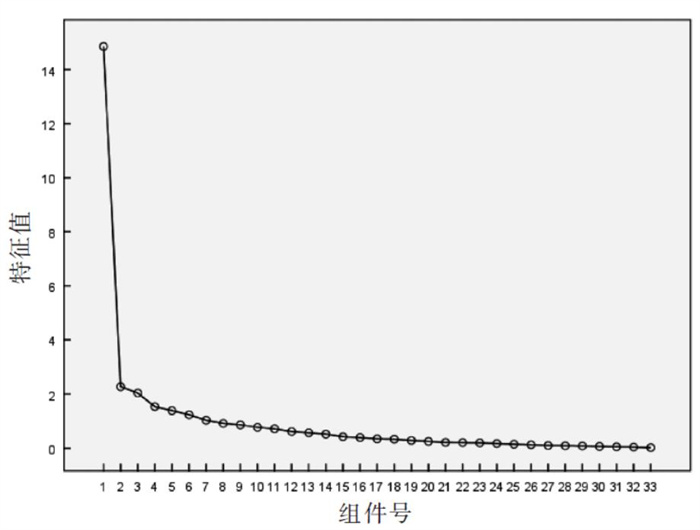Constructing evaluation system of urban emergency response capacity based on reliability and validity analysis and analytic hierarchy process
-
+ English摘要:目的 确立城市突发公共事件应急管理能力评价指标体系,提高地方政府突发公共事件应急管理能力,满足国家应急管理建设需求。方法 依据国家有关法规和标准,并参考相关文献,在专家小组评议的基础上,确立南宁市城市突发公共事件应急管理能力评价指标体系。回收81份有效问卷,采用SPSS 20.0统计学软件,对评价体系进行信度和效度分析;采用yaahp软件,以层次分析法(AHP)确定城市应急管理能力各级指标的权重。结果 初步构建的评价体系包括4个一级指标,34个二级指标。经信度和效度分析,删除4个2级指标,最终建构了4个一级指标、30个二级指标的城市突发公共事件应急管理能力评价指标体系。层次分析法确定的各一、二级指标及其权重为:“事故预防”(权重0.433 5)下设7个二级指标;“应急准备”(权重0.311 2)下设7个二级指标;“应急处置”(权重0.203 4)下设9个二级指标;“恢复与重建”(权重0.051 9)下设7个二级指标。二级指标中权重超过0.05的指标依次为法律法规(权重0.091 6)、突发公共事件技术监管(权重0.085 6)、设立应急机构(权重0.068 5)、建立监测预警系统(权重0.066 8)、突发公共事件责任落实(权重0.057 9)、辖区危险场所管控(权重0.057 8)、辖区风险评价与控制(权重0.053 1)、编制应急预案(权重0.051 6)、重大灾害投保(权重0.050 2)。结论 基于信度、结构效度验证的城市突发公共事件应急管理能力评价指标体系具有较好的科学性,符合我国应急管理的方针策略。在评价体系构建过程中,法律法规的完善与健全、应急机构的设置与权责划分非常重要,还要充分发挥保险机制在应急管理工作中的作用。
-
《国家突发公共事件总体应急预案》于2006年1月发布,将突发公共事件定义为“突然发生,造成或可能造成重大人员伤亡、财产损失、生态环境破坏和严重社会危害,危及公共安全的紧急事件;细分为自然灾害、事故灾难、公共卫生事件和社会安全事件四类[1]。在当今社会生活中,随着社会发展,突发公共事件变得越来越常见,不断考验着各级政府的应急反应机制以及应急管理能力。2020年初,各地相继出现新型冠状病毒肺炎(简称“新冠肺炎”)确诊病例后,各地方政府纷纷启动应急响应,然而在抗疫工作中,各地方政府面对突发公共事件时的应急能力存在较大差异,部分地方政府城市应急管理存在不足,现行的应急管理体制还存在着条块分割、定位模糊、沟通不畅、协调不力、重复建设以及资源有待整合与技术能力不足等深层次问题。因此,以政府为主导,对应急管理体系开展优化与升级非常重要[2]。
目前国内外学者对于应急管理的研究,多侧重于技术视角与制度建设: 如陈述等[3]使用阈值-加权方法试图构建重大突发事件应急响应的协同网络;陈思等[4]利用动态贝叶斯网络模型和离散马尔可夫过程,建立典型的水上交通事故(险情)船-岸联合应急和干预能力的定量评价模型;Memari等[5]针对空地救护车选址-分配-路径问题,设计了灾后临时应急管理系统,以减轻事故的影响。但现有关于应急能力评估体系的研究,或缺少对突发公共事件的考量,或仅注重自身专业领域,或仅仅基于经验总结,或缺少对体系信度和效度的分析。本研究拟克服上述缺点,以南宁市为目标城市,重新确立城市突发公共事件应急管理能力评价指标体系,旨在为科学构建城市应急评价体系提供依据与参考。
1. 资料与方法
1.1 体系的初步构建
城市应急管理能力评价是一项十分复杂的系统工程,受到多方面因素的影响。课题组以4R模型[6]即缩减(reduction)、预备(readiness)、反应(response)、恢复(recovery)为出发点,在参考大量文献[7-19]的基础上,建立了事故预防、应急准备、应急处置以及恢复与重建4个一级指标。接着进行分类整理与同义词整合,参照《中华人民共和国突发事件应对法》《中华人民共和国安全生产法》《突发公共卫生事件应急条例》《广西壮族自治区突发公共卫生事件应急办法》《广西壮族自治区实施 < 中华人民共和国突发事件应对法 > 办法》等法律、法规、地方法规规章[20-24],初步构建了40个二级指标,征求课题组5名专家学者组成的评议小组意见,采用“背对背”德菲尔法对指标进行投票,分为赞成、反对两个选项,得票≥ 4的指标保留,整理出34个二级指标,拟进入第二轮再次精选。
1.2 组建咨询专家
为了使收集的数据能科学地反映南宁市的城市应急管理能力,本研究的信度和效度问卷在设计时要求咨询专家须在南宁市生活3年以上,且具备一定的应急管理相关知识。课题组通过互联网定向投放83份问卷。专家主要来自广西大学安全工程专业、公共事业管理专业近十年来的毕业生以及导师推荐的部分具备应急管理知识的公务员,职业领域包括建筑、危险化学品、制造业、公共交通、消防、应急管理等。
在层次分析环节,课题组分别在大学、政府机构、卫生系统、工业界以及消防单位各联系两名咨询专家,共10人进行层次分析问卷调查,其中: 男性6人,女性4人;年龄38 ~ 51岁;正高级职称2名,副高级职称6名,中级职称2名;博士2名,硕士6名,大学本科2名。10名咨询专家须在南宁市生活10年以上,且具备至少5年的应急管理相关工作经验。
1.3 问卷调查和体系优化步骤
成立各层次专家组后,对初步构建的指标体系进一步优化。具体步骤为: 发放调查问卷进行评价体系优化——收集问卷进行数理统计——采取信度、效度分析来剔除部分体系指标——利用优化后的评价体系进行层次分析。
在信度和效度分析环节: 调查问卷共设计5题(第1题为一级指标的重要度判断,第2 ~ 5题为二级指标的重要度判断),涉及4个一级指标与34个二级指标,采用Likert 5分量表法打分: 1分为不重要,2分为较不重要,3分为一般,4分为重要,5分为非常重要。此环节主要目的是确认一、二级指标对应急能力评价体系的重要度,检验各指标独立性,优化与确定评价体系。在问卷星平台线上定向发放83份调查问卷,除去诸如数据填写不完整、填写时间过短(低于50 s)等因素造成的无效问卷2份,共回收有效问卷81份,有效回收率为97.5%。
在层次分析环节: 本研究基于“同一个层次内指标重要性两两比较”原则设置问卷,用于判断权重矩阵。量度分为9级,其中9级、7级、5级、3级、1级分别对应于绝对重要、非常重要、比较重要、轻微重要、同等重要;其中间值则表示重要性介于相邻两级之间。采取线上邀请专家评分,专家间独立评分、不组织讨论,以保证本次专家评分的科学性、准确性与客观性;收集专家数据后进行一致性检验。
1.4 信度和效度分析
1.4.1 信度分析
选用Cronbach’s α系数分析调查问卷的信度。问卷总表信度系数应在0.8以上,分表信度系数应在0.7以上;信度系数在[0.7,0.8]时,问卷的可信度处于可以接受范围,也可以适当调整;当总量表信度系数在0.7以下或者分量表系数在0.6以下,应重新修订量表或增删题项[25]。
1.4.2 效度分析
效度分析主要分为内容效度和结构效度。内容效度通常是参考专家意见并参考大量文献得出的结论,在体系初步构建时就已完成;本研究采用因子分析法来检验结构效度。
在使用因子分析前,利用SPSS 20.0软件中KMO检验以及球形Bartlett检验对数据进行检验,确认数据能否使用因子分析。Bartlett球形检验用于检验矩阵中各变量间的独立性。KMO值越接近于1,变量间的相关性越强,偏相关性越弱,因子分析的效果越好;当0.6 < KMO值< 0.7时可以进行因子分析,KMO值在0.6以下时需要考虑重新修订指标或增删题项[26]。因子载荷数值的大小表示变量与因子的相关程度,也就是因子对变量的重要程度,通常取[0.30,0.50],参考文献[27],本次研究剔除因子载荷小于0.45的指标。
1.5 层次分析法确定指标权重
城市突发公共事件应急管理能力评价指标体系中各个指标对结果的贡献度不同,这就要求为各个指标确定合理的权重。本研究利用yaahp软件对指标进行层次分析(analytic hierarchy process,AHP),计算权重。各级指标的判断矩阵参考德菲尔法在公共信息服务标准体系框架构建的应用[28],使用专家对各指标相较于目标层的重要性来建立,并获得相应的特征值,从而确定应急管理能力评价体系各因素间相对权重;计算一致性指标CI、平均随机一致性指标RI、CR检验判断矩阵的一致性。
$$ \mathrm{CI}=\frac{\lambda_{\max }-n}{n-1} $$ (1) 式中,λmax为最大特征根,通过相对重要性计算得到,判定矩阵计算结果的不一致性是否可以接受;n为唯一非零特征根,当CI = 0时,有完全的一致性,CI越大,不一致越严重。
为衡量一致性指标CI的大小,还需引入同阶平均随机一致性指标RI(定值)以及一致性比率CR值[29]。
$$ \mathrm{CR}=\frac{\mathrm{CI}}{\mathrm{RI}} $$ (2) 式中,CI为一致性指标;RI为随机一致性指标RI。当CR < 0.1时,认为该判断矩阵可以通过一致性检验。最终把各位专家对同一指标体系的权重进行汇总与算术平均,得出应急能力评价指标体系。
2. 结果
2.1 初步构建评价指标体系
初步构建的评价体系共包括4个一级指标,34个二级指标。其中“事故预防”下设8个二级指标: 法律法规、城市自然条件研究、突发公共事件教育宣传、突发公共事件技术监管、突发公共事件责任落实、辖区危险场所管控、辖区风险评价与控制、重大灾害投保;“应急准备”下设8个二级指标: 设立应急机构、建设应急专业队伍(如消防员等)、设立应急志愿者队伍、编制应急预案、建立监测预警系统、开展应急培训和演练、建设应急避难场所、应急物资储备;“应急处置”下设11个二级指标: 事件通报与沟通、群众疏散及安置、事发区域交通警戒、职能部门指挥决策、应急队伍抢险救灾、应急资源调配、应急通信保障、应急资金保障、应急医疗保障、区域协调联动、社会力量参与;“恢复与重建”下设7个二级指标: 事件现场清理、防疫与重建,恢复生产生活,重建社会秩序,应急损害评估,制定发布事故报告或事件通报,开展保险理赔工作,总结事件经验。该体系主要基于政府视角(建立的指标体系主要从政府应急工作层面进行考虑)而建立。
2.2 信度和效度分析结果
2.2.1 信度分析
对81份调查问卷进行信度检验,结果显示: (1) 总表的Cronbach’s α系数= 0.958 > 0.8,表明初步体系的内在信度非常高;(2) 四个一级指标下的二级指标信度: 事故预防0.791、应急准备0.862、应急处置0.928、恢复与重建0.835,均 > 0.70,可以认为四个一级评价指标体系的信度较好,仅可能需要对事故预防进行微调。
Yoo等[30]提出可以利用校正后项目与总分相关性(corrected item-total correlation,CITC)来进行进一步分析,相关系数越高表示题项与其他题项内部一致性越高,CITC实际值应至少 > 0.40。检验结果发现仅一级指标“事故预防”下设的二级指标“城市自然条件研究”的CITC值= 0.341 < 0.4,故予以剔除。
2.2.2 效度分析
对剩余的33个二级指标进行KMO和Bartlett球形检验,结果显示4个一级评价指标事故预防、应急准备、应急处置、恢复与重建的KMO值分别为0.745、0.839、0.886、0.743,均大于0.7(P < 0.01),表明数据适合进一步使用因子分析。
因子分析法是把多个指标简化为少数几个相互独立的综合变量,并确认主要因子充当主成分。因此分析结果显示: 在当前4个主成分(一级指标)的累计贡献率达60%以上,4个主成分的特征值λ ≥ 1,且碎石图平缓点位置出现在第4个主成分点(见表 1、图 1),故保留该前4个一级指标合理,可以分析二级指标的因子载荷,其结果显示: (1) 一级指标“事故预防”下,各二级指标因子载荷值为0.460 ~ 0.807 > 0.45;(2) 一级指标“应急准备”下,“开展应急培训和演练”指标因子载荷值为0.436 < 0.45,其余各二级指标因子载荷值为0.545 ~ 0.764 > 0.45;(3) “应急处置”下的“事发区域交通警戒”因子载荷值为0.437,“职能部门现场指挥决策”指标因子载荷值为0.443,其余各指标的因子载荷值为0.481 ~ 0.820均 > 0.45;(4) 一级指标“恢复与重建”下,各二级指标因子载荷值为0.592 ~ 0.783 > 0.45。故删除因子载荷值< 0.45的3个指标,建构最终共计30个二级指标的城市突发公共事件应急管理能力评价指标体系。
表 1 33个二级指标总方差解释组件 初始特征值 提取载荷平方和 旋转载荷平方和 总计 方差百分比 累积百分比 总计 方差百分比 累积百分比 总计 方差百分比 累积百分比 1 14.85 45.01 45.01 14.85 45.01 45.01 6.15 18.66 18.66 2 2.21 6.89 51.91 2.21 6.89 51.91 4.96 15.04 33.11 3 2.04 6.19 58.10 2.04 6.19 58.10 4.80 14.56 48.21 4 1.54 4.61 62.16 1.54 4.66 62.16 4.18 14.50 62.11 2.3 评价指标体系权重
负责层次分析的专家们在接收到问卷时,需要在同一个层次内对各指标重要性进行两两比较与赋值判断。收集10名专家在目标层“南宁市突发公共事件应急能力评价”层次下关于4个一级指标的相对重要度以及下设的30个二级指标的相对重要度,从而构建判断矩阵。
本研究在获取专家层次分析问卷原始数据后,经运算得出各专家在各阶段及总体上的一致性比率CR值,10名专家的总体一致性CR值为0.043 8 ~ 0.095 2,事故预防阶段CR值为0.036 8 ~ 0.098 3,应急准备阶段CR值为0.067 3 ~ 0.092 2,应急处置阶段CR值为0.039 2 ~ 0.099 2,恢复与重建阶段CR值为0.026 4 ~ 0.098 3,均 < 0.1,即经运算与校正,所有专家的各层次权重判断矩阵通过一致性检验。
对各位专家对同一评价体系的指标权重进行汇总与算术平均,得出南宁市突发公共事件应急管理能力评价指标体系权重见表 2。
表 2 南宁市城市突发公共事件应急管理能力评价指标体系权重一级指标 二级指标 二级指标权重 二级指标权重排序 一级指标权重 事故预防 法律法规 0.091 6 1 0.433 5 突发公共事件教育宣传 0.037 3 11 突发公共事件技术监管 0.085 6 2 突发公共事件责任落实 0.057 9 5 辖区危险场所管控 0.057 8 6 辖区风险评价与控制 0.053 1 7 重大灾害投保 0.050 2 9 应急准备 设立应急机构 0.068 5 3 0.311 2 建设应急专业队伍 0.037 9 10 设立应急志愿者队伍 0.034 5 13 编制应急预案 0.051 6 8 建立监测预警系统 0.066 8 4 建设应急避难场所 0.018 6 21 应急物资储备 0.033 3 14 应急处置 事件通报与沟通 0.020 1 20 0.203 4 群众疏散及安置 0.031 9 15 应急队伍抢险救灾 0.035 5 12 应急资源调配 0.022 7 17 应急通信保障 0.018 5 22 应急资金保障 0.020 7 19 应急医疗保障 0.022 3 18 区域协调联动 0.023 4 16 社会力量参与 0.008 3 26 恢复与重建 事件现场清理、防疫与重建 0.010 7 24 0.051 9 恢复生产生活 0.009 9 25 重建社会秩序 0.003 2 29 应急损害评估 0.005 4 28 制定发布事故报告或事件通报 0.011 7 23 开展保险理赔工作 0.003 1 30 总结事件经验 0.007 9 27 3. 讨论
我国在突发公共事件的应对上将面临一个长期、艰巨的过程,这就要求政府以及有关部门,要把应急管理作为政府治理的重要组成部分,把应急管理上升到整个经济、社会发展的战略高度[31],提升我国应对突发公共事件的能力,建立起一套现代化的行之有效的应急管理体系。
“城市应急能力”和“城市突发公共事件应急管理能力”二者为包含与被包含关系: 城市突发公共事件应急管理能力强调的是面对于突然发生,造成或者可能造成严重社会危害,需要采取应急处置措施予以应对,重点考核在应对突发公共事件时政府各部门管理能力,其主体为政府;而城市应急能力在此基础上,群众应急意识、城市应急储备、城市自身禀赋都是考量的点,其主体为城市整体。本次研究是基于政府视角做出的城市突发公共事件应急管理能力评价体系。
现行的关于城市应急管理能力评价体系的研究,一是各城市应急管理体系多构建于新冠肺炎疫情之前,往往侧重于自然灾害与事故灾难应急的设计,对将突发公共卫生事件纳入整体应急管理体系的考量较少;二是仅注重于自身专业领域的较多,没有统筹开展城市应急管理体系构建;三是考虑结构效度的较少,在进行应急能力体系设计时,通常基于文献阅读与专家小组评议,带有较大的主观性。也有部分学者注意到体系的信度和效度分析,在内容效度上进行了验证,但没有验证各因子构成的体系的结构效度,就开始层次分析或模糊评价。
本次研究为了克服以上种种缺陷,对包含突发公共卫生事件在内的多领域的城市应急管理能力评价体系进行统筹性的构建,并着重考虑了指标的结构效度,以在整体上保证研究的科学性和准确性。在体系构建的早期,参考了大量的文献并进行专家小组评议,以保证体系指标的内容效度。研究选取的专家为多个领域但是相关专业的资深学者,其自身积极程度、权威程度均有较好的保证;而对于专家在同一城市的要求,则是基于场域对决策的影响[32]做出的: 如地震多发带的专家可能更关心重大灾害投保、沿海城市的专家更在意辖区风险评价与控制等二级指标,故在针对城市尺度进行应急管理能力评价体系构建时应注重场域问题,本研究也尽可能选取同一时间、空间尺度的专家进行决策和评估。
“开展应急培训演练”这一二级指标被剔除,一是因为该指标效度有限,以城市为单位大规模进行应急培训和演练在成本效益上不占优;二是多领域专家的教育、工作背景存在较大异质性,导致其决策有一定显著差异。
在一级指标权重上,事故预防的权重为0.433 5,应急准备的权重为0.311 2,应急处置的权重为0.203 4,恢复与重建的权重为0.051 9,排序基本上也可以反映出我国“预防为主”的应急管理方针策略,符合事前预防在安全应急工作中的实际重要度。二级指标中,权重最高的为法律法规,高达0.091 6,突发公共事件技术监管也达0.085 6。可见应急管理体系构建中法律法规的完善与健全、实际监管非常重要。国际上许多发达国家亦非常重视应急管理的立法工作,如日本在应急管理方面制定了多达227部法律法规[33]。我国各级政府更要坚持应急管理“立法先行”的工作方针,不断完善地方法规与各类应急规章制度,营造应急管理的法制氛围;不断建立健全地方政府应急管理专家咨询库,定期开展突发公共事件技术监管巡查、自检工作。与此同时,设立应急机构的权重为0.068 5,说明了在应急管理体系中,应急机构的设置与权责划分至为重要,如游志斌等[34]指出美国政府高度重视应急准备管理框架的整体设计,重视应急机构的设置,以更好地推动公共安全治理工作的现代化与科学化。而“事故预防”阶段下设二级指标如突发公共事件技术监管、责任落实等权重均超过0.05,再次验证其整体重要度。
保险是转移突发公共事件风险的一个重要途径,在本研究中重大灾害投保的权重也超过0.05。在国内如山东省人民政府就建立了全省灾害民生综合保险制度,充分发挥保险机制在应急管理工作中的作用,是加快构建社会力量和市场机制参与灾害应急管理体系的制度创新[35]。政府应该针对如洪灾、台风、动物疫情与生产事故等突发公共事件建立重大灾害投保制度,转移部分风险。
而在自然灾害类、事故灾难类与社会安全类突发公共事件来袭时,往往会对事件发生区域造成较大的破坏,这就需要政府建立足够的应急避难场所,完善群众疏散及安置制度。本次研究得出在“应急处置”下,应急队伍抢险救灾的权重为0.035 5,群众疏散及安置的权重为0.031 9,为同级指标中最高。政府应该考虑建设如防空洞、紧急避难层等应急避难场所,还可以考虑利用学校、体育馆等公共资源,在“战时”发挥应急场所作用,做到平战结合。
应急管理能力建设是一个动态的过程,本次研究得到的城市突发公共事件应急管理能力评价指标体系应急管理能力评价指标体系,其适用性、有效性还有待在不同城市或在同一城市的不同时期进行进一步的验证和完善。
作者声明 本文无实际或潜在的利益冲突 -
表 1 33个二级指标总方差解释
组件 初始特征值 提取载荷平方和 旋转载荷平方和 总计 方差百分比 累积百分比 总计 方差百分比 累积百分比 总计 方差百分比 累积百分比 1 14.85 45.01 45.01 14.85 45.01 45.01 6.15 18.66 18.66 2 2.21 6.89 51.91 2.21 6.89 51.91 4.96 15.04 33.11 3 2.04 6.19 58.10 2.04 6.19 58.10 4.80 14.56 48.21 4 1.54 4.61 62.16 1.54 4.66 62.16 4.18 14.50 62.11 表 2 南宁市城市突发公共事件应急管理能力评价指标体系权重
一级指标 二级指标 二级指标权重 二级指标权重排序 一级指标权重 事故预防 法律法规 0.091 6 1 0.433 5 突发公共事件教育宣传 0.037 3 11 突发公共事件技术监管 0.085 6 2 突发公共事件责任落实 0.057 9 5 辖区危险场所管控 0.057 8 6 辖区风险评价与控制 0.053 1 7 重大灾害投保 0.050 2 9 应急准备 设立应急机构 0.068 5 3 0.311 2 建设应急专业队伍 0.037 9 10 设立应急志愿者队伍 0.034 5 13 编制应急预案 0.051 6 8 建立监测预警系统 0.066 8 4 建设应急避难场所 0.018 6 21 应急物资储备 0.033 3 14 应急处置 事件通报与沟通 0.020 1 20 0.203 4 群众疏散及安置 0.031 9 15 应急队伍抢险救灾 0.035 5 12 应急资源调配 0.022 7 17 应急通信保障 0.018 5 22 应急资金保障 0.020 7 19 应急医疗保障 0.022 3 18 区域协调联动 0.023 4 16 社会力量参与 0.008 3 26 恢复与重建 事件现场清理、防疫与重建 0.010 7 24 0.051 9 恢复生产生活 0.009 9 25 重建社会秩序 0.003 2 29 应急损害评估 0.005 4 28 制定发布事故报告或事件通报 0.011 7 23 开展保险理赔工作 0.003 1 30 总结事件经验 0.007 9 27 -
[1] 国务院. 国家突发公共事件总体应急预案[J]. 中国安全科学学报, 2006, 16(2): 108. https://www.cnki.com.cn/Article/CJFDTOTAL-FHKH200601003.htm [2] 薛澜, 沈华. 五大转变: 新时期应急管理体系建设的理念更新[J]. 行政管理改革, 2021(7): 51-58. https://www.cnki.com.cn/Article/CJFDTOTAL-XZGL202107005.htm [3] 陈述, 余迪, 郑霞忠, 等. 重大突发事件的协同应急响应研究[J]. 中国安全科学学报, 2014, 24(1): 156-162. https://www.cnki.com.cn/Article/CJFDTOTAL-ZAQK201401030.htm [4] 陈思, 魏晓阳, 吴青, 等. 基于动态贝叶斯的水上交通应急能力评估模型[J]. 统计与决策, 2018, 34(2): 57-60. https://www.cnki.com.cn/Article/CJFDTOTAL-TJJC201802014.htm [5] MEMARI P, TAVAKKOLI-MOGHADDAM R, NAVAZI F, et al. Air and ground ambulance location-allocation-routing problem for designing a temporary emergency management system after a disaster[J]. J Eng Med, 2020, 234(8): 812-828. doi: 10.1177/0954411920925207
[6] HEATH R L. Crisis management for managers and executives: business crises, the definitive handbook to reduction, readiness, response, and recovery[M]. New York: Pitman Pub, 1998.
[7] 张建军, 杨璐, 魏攀一, 等. 公路交通突发事件应急能力评估理论体系[J]. 公路交通科技, 2020, 37(2): 82-88. https://www.cnki.com.cn/Article/CJFDTOTAL-GLJK2020S2016.htm [8] 邓砚, 聂高众, 苏桂武. 县(市)地震应急能力评价指标体系的构建[J]. 灾害学, 2010, 25(3): 125-129. https://www.cnki.com.cn/Article/CJFDTOTAL-ZHXU201003028.htm [9] 齐恩铎, 高子杰. 城市地铁公共应急能力评价研究——以石家庄市地铁为例[J]. 科技与创新, 2021(20): 117-120. https://www.cnki.com.cn/Article/CJFDTOTAL-KJYX202120050.htm [10] 仇蕾洁, 马桂峰, 张雪文, 等. 农村基层突发公共卫生事件应急能力评价指标体系构建研究[J]. 中国卫生事业管理, 2017, 34(11): 801-804. https://www.cnki.com.cn/Article/CJFDTOTAL-ZWSG201711003.htm [11] 王晓东, 吴群红, 郝艳华, 等. 突发公共卫生事件应急能力评价指标体系构建研究[J]. 中国卫生经济, 2013, 32(6): 47-50. https://www.cnki.com.cn/Article/CJFDTOTAL-WEIJ201306015.htm [12] 孙宁宁. 城市突发公共事件应急能力评价指标体系研究[D]. 大连: 大连理工大学, 2009. [13] 杨凤平. 北京市应急管理能力评价指标体系研究[D]. 北京: 首都经济贸易大学, 2014. [14] 申奇锦. 政府生产安全事故应急管理能力评价指标体系研究[D]. 北京: 中国地质大学, 2016. [15] 韩传峰, 叶岑. 政府突发事件应急能力综合评价[J]. 自然灾害学报, 2007, 16(4): 149-153. https://www.cnki.com.cn/Article/CJFDTOTAL-ZRZH200704028.htm [16] 田依林, 杨青. 突发事件应急能力评价指标体系建模研究[J]. 应用基础与工程科学学报, 2008, 16(2): 200-208. https://www.cnki.com.cn/Article/CJFDTOTAL-YJGX200802008.htm [17] 邓云峰, 郑双忠, 刘功智, 等. 城市应急能力评估体系研究[J]. 中国安全生产科学技术, 2005, 13(6): 33-36. https://www.cnki.com.cn/Article/CJFDTOTAL-LDBK200506007.htm [18] 王绍玉. 城市灾害应急管理能力建设[J]. 城市与减灾, 2003(3): 4-6. https://www.cnki.com.cn/Article/CJFDTOTAL-CSJZ200303000.htm [19] 郭太生, 寇丽平. 重点单位突发事件应急能力评价指标体系研究[J]. 中国人民公安大学学报(社会科学版), 2010, 26(3): 80-88. https://www.cnki.com.cn/Article/CJFDTOTAL-GADX201003014.htm [20] 中华人民共和国. 中华人民共和国突发事件应对法: 中华人民共和国主席令第六十九号[A]. 2007-08-30. [21] 中华人民共和国. 中华人民共和国安全生产法: 中华人民共和国主席令第七十号[A]. 2021-06-10. [22] 中华人民共和国国务院. 突发公共卫生事件应急条例: 中华人民共和国国务院令第376号[A]. 2011-01-08. [23] 广西壮族自治区人民政府. 广西壮族自治区突发公共卫生事件应急办法: 自治区人民政府令第3号[A]. 2003-07-22. [24] 广西壮族自治区人民政府. 广西壮族自治区实施《中华人民共和国突发事件应对法》办法[A]. 2013-03-28. [25] 吴明隆. 问卷统计分析实务: SPSS操作与应用[M]. 重庆: 重庆大学出版社, 2010. [26] 廖宇. 基于GERD患者报告临床结局中医测量量表的编制及信度、效度分析[D]. 北京: 北京中医药大学, 2012. [27] 成子娟, 侯杰泰, 温忠麟. 结构方程模型及其应用[M]. 北京: 教育科学出版社, 2004. [28] 白文琳, 黄林杰. 我国公共信息服务标准体系框架构建研究[J]. 情报科学, 2020, 38(12): 43-50. https://www.cnki.com.cn/Article/CJFDTOTAL-QBKX202012007.htm [29] 魏一凡. 基于层次分析法的某城市综合体施工阶段造价影响因素研究[D]. 徐州: 中国矿业大学, 2021. [30] YOO B, DONTHU N. Developing a scale to measure the perceived quality of an internet shopping site (SITEQUAL)[J]. QJEC, 2001, 2(1): 31-45.
[31] 杜红. 我国突发公共卫生事件中政府应急管理研究[D]. 西安: 长安大学, 2014. [32] 李全生. 布迪厄场域理论简析[J]. 烟台大学学报(哲学社会科学版), 2002, 15(2): 146-150. https://www.cnki.com.cn/Article/CJFDTOTAL-YTXS200202004.htm [33] 陈成文, 蒋勇, 黄娟. 应急管理: 国外模式及其启示[J]. 甘肃社会科学, 2010(5): 201-206. https://www.cnki.com.cn/Article/CJFDTOTAL-GSSH201005053.htm [34] 游志斌, 薛澜. 美国应急管理体系重构新趋向: 全国准备与核心能力[J]. 国家行政学院学报, 2015(3): 118-122. https://www.cnki.com.cn/Article/CJFDTOTAL-LJXZ201503021.htm [35] 山东省人民政府办公厅. 山东省人民政府办公厅关于开展全省灾害民生综合保险工作的通知: 鲁政办字〔2019〕64号[A]. 2019-03-30. -
期刊类型引用(2)
1. 陈妙霞,冯健文,陆宝君,吴超雄. 基于多元回归方程模型的大学生劳动素养评价指标体系构建研究. 西部素质教育. 2024(24): 18-23 .  百度学术
百度学术
2. 闫力男,张润钊,徐爱,龚超. 医疗机构紧急医学救援人员胜任力评价指标体系研究. 中国医院. 2023(10): 75-78 .  百度学术
百度学术
其他类型引用(9)





 下载:
下载:

